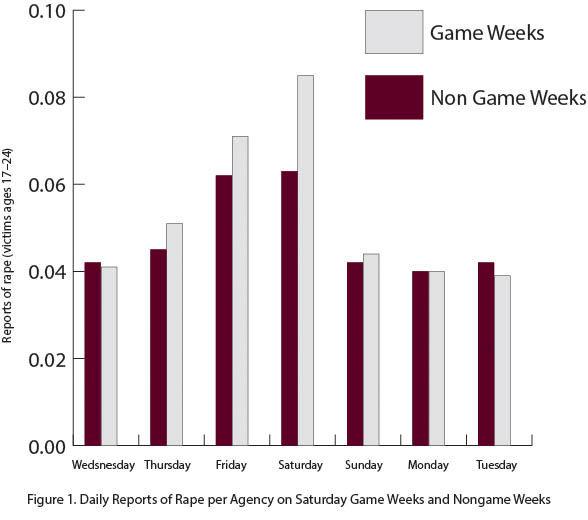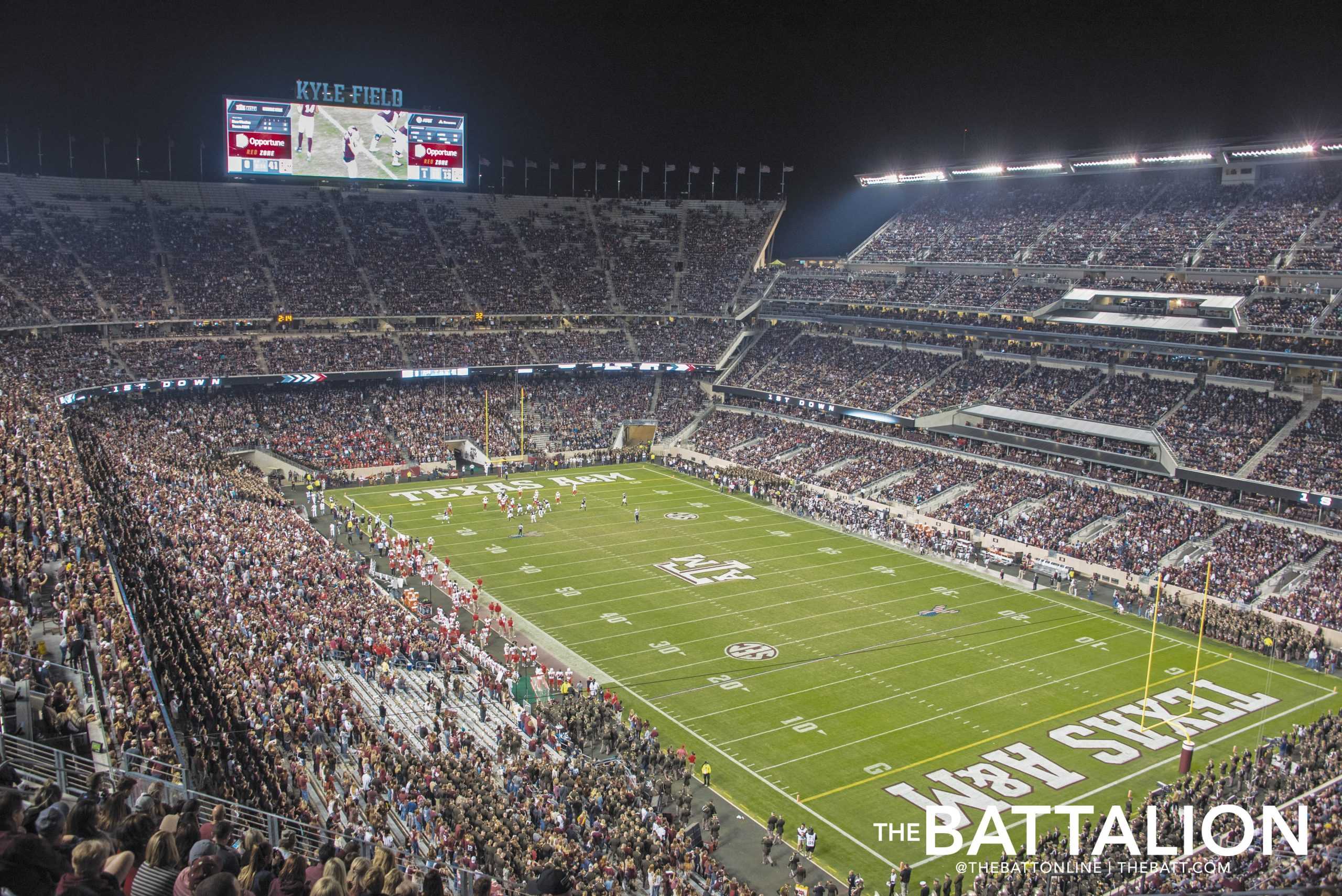According to the Association of American Universities’ Campus Climate Survey on Sexual Assault and Sexual Misconduct, over 20 percent of female undergraduate students have been sexually assaulted.
In a new research paper, Texas A&M professor Jason Lindo’s data looks to show the correlation between college football games and increased reports of sexual assaults.
In his recently published online paper, “College Party Culture and Sexual Assault,” Lindo, an associate professor of economics, studied how Division I football games affect partying and drinking along with an increase of reported rapes on certain nights.
Lindo said he knew there was a connection between alcohol consumption and sexual assault and wanted to look at events that intensify the behavior to learn about the effects of the activity.
“We wanted to quantify the degree to which events that intensify partying and alcohol consumption cause increases in reports of rape and to document what types of reports are affected the most,” Lindo said. “This is why we chose to investigate the effects of Division I football games. The events very clearly intensify partying and drinking on college campuses. So they provide an opportunity to learn about the causal effects of such activities.”
Working with Peter Siminski, associate professor of economics at the University of Technology Sydney, and Isaac Swenson, assistant professor of economics at Montana State University, Lindo said the paper used information from the National Incident Based Reporting System (NIBRS) to look at data from 96 different universities, not including A&M, on or around the time of a football game day. The data collected from the NIBRS is a voluntary-based program for universities and is collected by the FBI.
“Our analysis draws upon hourly reports of rape to campus and local police departments serving students at schools with Division I football programs over a 22-year-period [from 1991-2012],” Lindo said. “Using this data, we estimate the degree to which reports of rapes are elevated for game days over and above the number that might be expected based on the day of the week the game is played, usually Saturday, and over and above the elevated number that might be expected based on the time of year the game is played.”
Lindo said the research found that football games increased the rate of reported sexual assault with 17-24 year old victims by 28 percent. On home game days, the effect is seen to increase by 41 percent and away game days; the effect is at 15 percent.
“The effects are larger for schools with more prominent football teams and for relatively prominent games,” Lindo said. “Much of the effect is due to 17-24 year old offenders.”
In regards to how these numbers correlate to A&M, Lindo said they are slightly more than what he would expect A&M to produce.
“It’s important to keep in mind that the effects we estimate represent an average across a large number of universities and colleges,” Lindo said. “The effects will be larger for some schools and smaller than others. Along these lines, we find that the effects are bigger for schools that have been listed as ‘party schools’ by the Princeton Review, and smaller, but still significant, for other schools. Based on that finding, I’d expect the effects to be smaller than average at A&M.”
The research also shows how different types of game outcomes can influence the size of the effect, Lindo said. Outcomes like upset wins have the largest effect on alcohol offenses and the largest effects on sexual assault.
“It seems when a team wins unexpectedly, fans celebrate more than usual,” Lindo said. “This is also accompanied by higher rates of sexual assault.”
Lindo said that through this research they found that Division 1A football games cause an estimated 724 rapes of college-aged victims per year. This translates into five percent of fall semester rapes of college-aged victims in college areas.
“Though we can only speculate, it seems likely that these results translate to related contexts, such as ‘rush week,’ spring break and other big sport events,” Lindo said. “There is evidence of drinking increases as a result of March Madness and similar effects likely exist outside the college realm.”
Swenson said when going into this research, they knew of the earlier research that had gone on between alcohol consumption and sexual assaults and they wanted to establish a causal effect that drives these actions on college campuses.
“We wanted to establish a more concrete link between the partying and college culture and sexual assault,” Swenson said. “Does the degree of which football games intensify partying and alcohol consumption actually causes increases in reports of rape. We wanted to contribute to a literature that had established an association but hasn’t necessarily nailed down a causal link.”
With the research, Swenson said he hopes administrators and individuals look at the results and seek way to decrease the spikes of rates of reported sexual assault that occur during football game days.
“There are plenty of interventions that universities are trying out to combat this issue,” Swenson said. “As folks look at our analysis and results we document specific types of rape reports that escalate and that can hopefully be used in information campaigns to inform prevention efforts.”
Lindo said the results of the study showed the importance of bystanders taking action when confronted with situations involving sexual assault.
“These results don’t change the importance of bystander interventions, or other efforts to promote safety,” Lindo said. “They do suggest a need for greater awareness and stronger efforts around gamedays, and other events that intensify partying.”
Daniel Pugh, vice president for Student Affairs, said Lindo’s study should be presented to students across campus, in an effort to combat sexual assault.
“I would encourage student government, Greek letter organizations and others to invite Dr. Lindo to present his findings to groups of key student leaders who could then discuss his findings in relation to our own campus culture,” Pugh said. “I know some of our Student Affairs staff would welcome the opportunity to be part of this presentation and participate in the discussion with student leaders.”
According to the Green Dot Bystander Intervention Training Program, which teaches A&M faculty, staff and students to be aware of potential violence around them, there are a number of ways bystanders can help in situations involving sexual assault. Seeking professional help, providing victims with resources, speaking out against potential perpetrators, watching over friends when in a situation where sexual assault could happen and offering friends sober rides home are among the many actions that can be taken. Additional information about Green Dot can be found on their website.
Study finds home football games elevate cases of sexual assault
February 1, 2018

Photo by Anthony Pangonas info via study
Econ Research Graph
0
Donate to The Battalion
$1765
$5000
Contributed
Our Goal
Your donation will support the student journalists of Texas A&M University - College Station. Your contribution will allow us to purchase equipment and cover our annual website hosting costs, in addition to paying freelance staffers for their work, travel costs for coverage and more!
More to Discover













